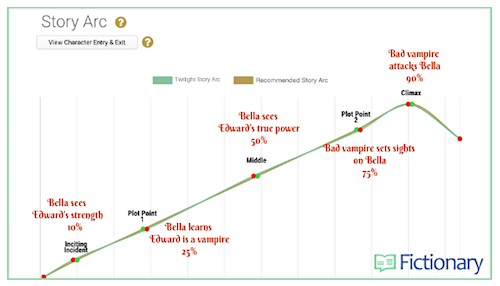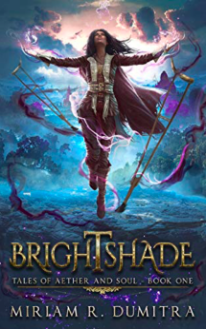How to Create the Perfect Story Arc

Every year, we’re lucky to have great sponsors for our nonprofit events. Today, our sponsor Fictionary has put together a step-by-step guide for creating the perfect story arc:
One of the best ways to improve your novel is to look at the way that successful authors have crafted their story arcs. You can use this information to revise your NaNoWriMo novel and tell a story your readers love.
Spoiler alert! We’re about to delve into Stephenie Meyer’s blockbuster novel Twilight while paying attention to the plot points that keep the story moving.
You may be familiar with the simplest form of a story arc:
The inciting incident is the moment the protagonist’s world changes in a dramatic way. Readers expect something to trigger the protagonist to act. If the inciting incident doesn’t occur in the first 15% of your novel, you need a strong reason for delaying it.
I recommend that you write your inciting incident as a dramatic scene and not as backstory or narrative summary. This enables the reader to experience the event at the same time as the protagonist and increases your chances of getting the reader emotionally involved.
Twilight’s Inciting Incident: Bella has already met Edward. This leads up to the inciting incident where Edward saves Bella from being killed in a parking lot. She gets her first glimpse of his powers and is set on her path of discovering more about him.
Twilight’s Inciting Incident happens 10% into the story. The percentage is based on the word count.
2. Plot Point OnePlot Point One is the point of no return—your character can’t back out of the central conflict. Your character may be obligated to take action, they cannot return to the way the world was before, or their desire for something overrules all else. There must be something at stake, because if the character doesn’t care about the outcome, a reader won’t care either.
Plot Point One should occur between 20% and 30% in your novel. If this plot point comes too late, the story will feel like it’s dragging. If it comes too early, the story will feel rushed or lacking in depth.
Twilight’s Plot Point One: Bella suspects that Edward is a vampire, but she decides to pursue him anyway. Edward has emotional power over Bella.
Twilight’s Plot Point One happens 25% into the story.
3. The MidpointOften the Midpoint is where an author struggles to keep the story interesting. To keep your story exciting, you’ll need to find some way to raise the stakes of your story with a life-changing, exceptional, or threatening event.
Ideally, this is where you’ll be taking your readers on a journey where the protagonist moves from a reactionary mode to a proactive mode.The Midpoint should occur between 45% and 55% in your novel. If the Midpoint comes too early or too late, the story won’t feel balanced.
Twilight’s Midpoint: Edward reveals his true powers as a vampire to Bella. He saves her from an attack, and this strengthens how she feels about him.
By now it should be no surprise that Twilight’s midpoint happens at 50% of the story.
4. Plot Point TwoAt Plot Point Two, the protagonist must work hard to get what they want or lose everything. Plot Point Two should occur between 70% and 80% of your novel.
Plot Point Two will be a low point for your protagonist. Their actions since the middle have caused disaster, or they become more determined to reach their goal.
Twilight’s Plot Point Two: A bad vampire decides to go after Bella, and Bella must leave her home. Bella wants to survive but not if it means risking those she loves.
Twilight’s Plot Point Two happens 75% into the story.
5. The ClimaxThe Climax scene is where you get to shine as an author. Every word you’ve written up to this point will pay off. Ideally, the climax scene (or scenes) will have the highest level of conflict, the greatest tension, or the most devastating emotional upheaval.The protagonist must be in your Climax scene, or you risk alienating your reader. The protagonist should face the biggest obstacle in the story and determine their own fate.
The climax should happen somewhere around 90% into your novel. Too early, and the reader may get impatient with a long resolution and skim to the end. Too late, and the resolution may lack depth or satisfaction.
Twilight’s Climax: Bella is lured into a trap. She faces down the evil vampire and gets injured.
And you guessed it. Twilight’s Climax happens 90% into the story.
6. The ResolutionThe resolution is everything that happens after the climax. It shouldn’t be longer than 10% of your total story. This is the time to give the reader an emotional resolution as well as tie up any loose ends.
Twilight’s Resolution: Bella and Edward are home, safe, and together, but when Bella tries to persuade Edward to turn her into a vampire, this leaves the reader questioning what happens next.
 Fictionary Author Hits #1 on Amazon
Fictionary Author Hits #1 on AmazonLast year, Miriam R. Dumitra won the Fictionary Finish Your Novel contest and received a lifetime subscription to Fictionary.
She put Fictionary to great use and her debut novel Brightshade recently hit #1 on Amazon in the category of Steampunk Science Fiction.
Miriam was also a 2018 NaNoWriMo winner, so there’s another book coming. Congratulations Miriam!
How Fictionary HelpsEditing is hard. Fictionary makes it easier with online software that simplifies and automates story editing. Use Fictionary to improve the structure, characters, plot, and settings of your NaNoWriMo novel.
A perfect tool to help complete your revision pledge. Within seconds, Fictionary automatically creates your cast of characters, links characters to scenes, calculates word count per scene, draws your story arc, and then guides you through a complete scene-by-scene revision.
Fictionary “Now What?” 50% Discount OfferSign Up for Fictionary using coupon code NOWWHAT2019 and get Fictionary for just $10/month.
No credit card required. Try free for 14 days and cancel anytime. Includes our 13-lesson story editing course delivered to your inbox. Signup required by March 31st, 2019 to lock in the 50% discount for 3 months.

Kristina Stanley is an editor, author, and CEO of Fictionary. She’s the best-selling author of the Stone Mountain Mystery Series, Look The Other Way, and The Author’s Guide to Selling Books To Non-Bookstores. Her short stories are published in Ellery Queen Mystery Magazine and Voices from the Valley anthology. She won the Audrey Jessup Capital Crime Writing award and her work was shortlisted for the Crime Writers of Canada Unhanged Arthur and the Crime Writers’ Association Debut Dagger.
Chris Baty's Blog
- Chris Baty's profile
- 63 followers



